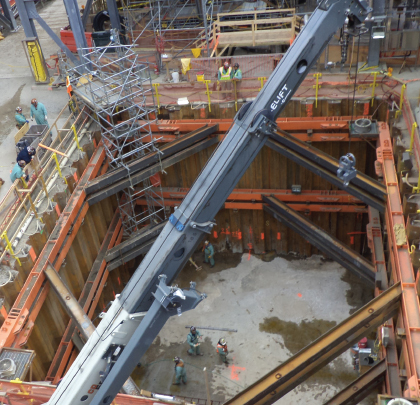Project benefits from hydraulic bracing to safely shore large pit
Completing a cast-in-place project that measures 46 feet wide by 39 feet long by 35 feet deep near the shores of Lake Michigan is a challenging project in and of itself. Now add in the challenge of being in the middle of an active British Petroleum (BP) refinery—this is the unique situation that Superior Construction Company, Inc. faced.
“When the project started in February 2012, my original plan was to use a slide rail shoring system,” says Paul Armstrong, superintendent for Superior Construction. “I went to the Internet and started searching for slide rail shoring systems, and that brought me to GME’s website. After a couple of conversations, they [GME] sent two representatives over to review the project in person.”
One of those people was Dennis Parker, product manager with GME. “After meeting with Paul, we had a good idea of what he wanted and how he wanted to proceed with this project,” recalls Parker.
THE PROJECT
Originally, the project was designed to be three smaller pits, meant to be used for sulfur retention. As the project progressed, the three small pits morphed into one large pit, located in the middle of the active refinery. With the change of location and the change to one large pit, some site demolition was needed, which required the vibration alarms to be removed.
“With the partial site demolition that needed to occur and the vibration alarms removed, everybody involved in the project turned to sheeting,” notes Parker. “That opened the door for GME and Sunbelt Rentals Pump & Power Services, to quote our new MD Bracing system.”
“We [Superior Construction] already had trench boxes on site from Sunbelt,” adds Armstrong. “They were already an approved vendor through BP; it just made the whole process a little easier.”
“Sheeting and bracing seemed like it was a great deal that saved the client time and money by doing one large pit instead of three smaller ones,” says Robert Morrow from Jacobs Engineering, the general contractor for the BP project.
“With the MD Bracing System now able to be used, we [GME] contacted DH Charles Engineering, Inc., to have them perform the site specific engineering for the project,” comments Parker.
“First look at the job, (a year prior to actually breaking ground), this project appeared to be a very good candidate for the use of hydraulic bracing,” comments Jasper Calcara, P.E., president of DH Charles Engineering, Inc. “With the phasing of bracing installation and removal, along with the other aspects of the design, hydraulic bracing was the leading candidate.”
With stamped and approved plans in place, using 50-foot-long SZ-21 Sheeting with four sets of the MD Brace rings, the requirement changed. “After multiple revisions, over the course of a year, it was finally decided that the design would be based on groundwater level at 17 feet below grade,” adds Calcara.
With the final shoring design submitted and approved, the project was able to break ground, under tight time constraints.
CHALLENGES TO SUCCESS
The success of this project relied on constant communication between all parties. “From GME’s standpoint, we wanted to give Superior Construction the closest thing we could to a turnkey operation,” mentions Parker. “That meant, not only did GME source the sheets needed for the system, we had an installation consultant out on-site to instruct them on installation and removal of the system just as we do with our slide rail shoring system.”
Overall, once the project got underway, I had no issues with the system that weren’t quickly solved.
Paul Armstrong | Superintendent, Superior Construction
Access to the site was another minor obstacle that had to be overcome. Since the project was taking place inside an active refinery, space was limited. The excavating was done by a John Deere 350 and an 85 D mini. All other equipment needed for the site had to be lifted over a 70-foot-tall by 30-foot-wide wall by a crane.
With the project commencing under tight time constraints, one thing stood out about the system: the flexibility of the MD Brace system. This was the first time that Superior Construction had used a system like the MD Brace, so there was a small learning curve. However, by using the MD Brace system, Superior Construction was able to gain some advantages over using a traditional beam and cut process with sheet pile. “With the MD Brace, we didn’t have to worry about welding or the exposure involved with trying to place beams,” adds Armstrong. “That allowed us to save a lot of labor time.”
“Being a hydraulic system, [the MD Brace] provided an extra level of protection to the adjacent structures by actively pushing against the sheets, and minimizing potential movement,” notes Calcara.
The MD Brace has the adjustability to work with rectangular and non-rectangular excavations to be safely shored. “Overall, once the project got underway, I had no issues with the system that weren’t quickly solved,” says Armstrong. “I would push to use the MD Brace again on a similar project, especially one with similar time constraints.”
■ ■ ■
[divider]
ABOUT THE AUTHORGME is the producer of the world’s most complete line of trench shoring and shielding equipment. The products offered range from a single hydraulic shore system, trench shields, slide rail systems, and hydraulic bracing systems. For more information, call 800.248.2054, or visit www.gme-shields.com.
Modern Contractor Solutions, MAY 2014
Did you enjoy this article?
Subscribe to the FREE Digital Edition of Modern Contractor Solutions Magazine!


